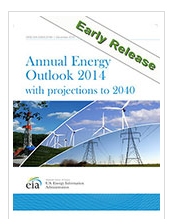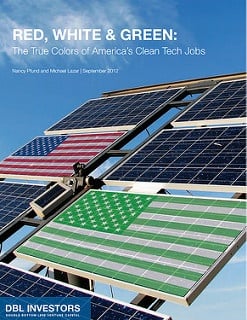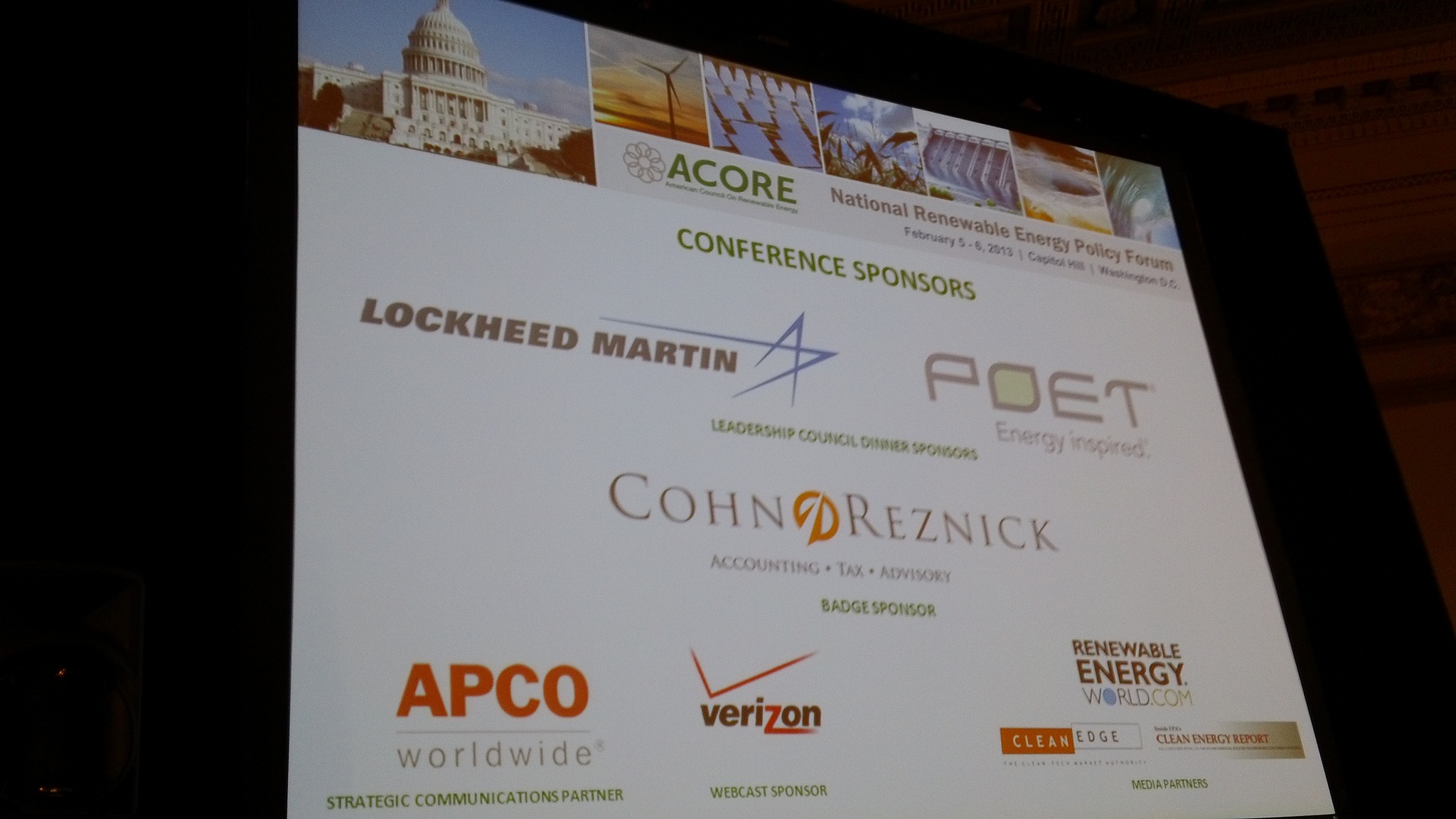Insights
Scaling Clean
At Greentech Media, Pulse Energy CEO David Heliwell has some excellent, helpful tips about "cutting through the noise in cleantech." Here's an excerpt.
Continue ReadingBob Pickard has worked for dirty energy public relations firms in the past, but he's dead on correct and exhaustive in this piece ("The Climate Change PR Disaster"). A few key points.
Continue ReadingBy Ross Chanin & Emilee Pierce
Continue ReadingHere are five recommended reads for today (1/2/14).
Continue ReadingEIA Renewable Energy Forecast Isn't Just Wrong, It's Wildly, Laughably Too Low
I hate to criticize the federal agency I worked at for 17+ years, especially since the Energy Information Administration (EIA) does great work in many areas (e.g., data collection, energy market and oil supply disruption analysis). But when it comes to long-term energy forecasting (whether we're talking prices, production, consumption, imports, whatever), I'm sorry to say, EIA has been not just wrong, time and time again, but laughably, outrageously wrong. And, sadly, their latest Annual Energy Outlook (the AEO - with "forecasts," using the word VERY loosely, out to 2040) continues that abysmal tradition. More on the AEO shortly. But first, let's review EIA's track record on long-term forecasting, from a recent article by Old Dominion University Professor Steve Yetiv and me in the Journal of Energy Security.
*Looking at EIA's 2005 AEO (note: this is somewhat random, but you'd find the same problems in pretty much ANY year's AEO), EIA forecast 2013 oil prices would be around $25-$30 per barrel, with gasoline prices of around $1.50/gallon. The actual prices? More like $100 per barrel for oil and $3.50/gallon for gasoline in the US market. That's off by a factor of 3-4 fold. Yikes!
*Back in 2005, EIA forecast US crude oil production would reach about 5.7 million barrels per day (bbl/d) in 2013, with Lower-US-48 production declining steadily after 2009. Actual US production so far in 2013? How about 7.3 million barrels per day (bbl/d) and rising fast? That's wildly off, both directionally and in absolute terms (by 1.6 million bbl/d).
*Likewise, the 2005 EIA forecast for US natural gas production in 2013 was wildly off -- about 20.6 trillion cubic feet (Tcf), compared to actual production of 24.2 Tcf. Not even close.
*EIA was also wildly off on U.S. gross oil imports, forecasting that they would rise sharply, from 12.3 million bbl/d in 2003 to 20.2 million bbl/d in 2025. What's actually happened so far is that US gross oil imports have fallen sharply, from 12.3 million bpd in 2003 to just 9.7 million bpd in 2013. US net oil imports have fallen even more sharply, from 11.2 million bpd in 2003 to 6.7 million bpd in 2013. EIA predicted the exact opposite.
*EIA's 2005 long-term forecast also missed the future price of natural gas in the US by a huge margin: a forecast price for 2012 of $3.80/thousand cubic feet (mcf) compared to the actual price of $10.66/mcf. That's not even close; heck, it's not even close to being close!
*In 2005, EIA forecast that U.S. solar power capacity would hit about 1.2 GW in 2013. Where are we right now? According to Greentech Media, the U.S. is closing in (if it already hasn't passed) the 10 GW mark in solar PV capacity right about now, and that's not even counting solar thermal power generating capacity (according to this article, you can add another 1 GW or so of U.S. solar thermal power capacity). In sum, EIA forecast 1.2 GW of U.S. solar power capacity in 2013; the actual figure is around 11 GW - nearly 10 times higher than EIA forecast!
*In 2005, EIA forecast that U.S. wind power capacity would reach about 9 gigawatts (GW) in 2013. Where, in fact, are we right now? According to theAmerican Wind Energy Association (AWEA), installed U.S. wind power capacity at the end of 2012 was 60 GW. Quick math: EIA's forecast of 9 GW compared to an actual 60 GW? That's off by a factor of nearly 7!
We could go on and on with this, but you get the picture: EIA has basically ZERO ability to forecast long-term energy trends even close to correctly.Let me emphasize: it's not that EIA is off by a just a bit; they're off by orders of magnitude. In that context, let's look at their latest long-term "forecasts" for renewable energy.
Continue ReadingHere are five recommended reads for today (12/2/13).
Continue ReadingHere are five recommended reads for today (10/11/13).
Continue ReadingHere are five recommended reads for today (10/9/13).
Continue ReadingHere are five recommended reads for today (10/2/13).
Continue ReadingBy Dave Georges, Tigercomm Senior Vice President
Continue ReadingHere are five recommended reads for today (9/10/13).
Continue ReadingBy Mark Sokolove, Executive Vice President of Tigercomm
Continue ReadingVideo: Tom Steyer Discusses Anti-Keystone Tar Sands Pipeline Campaign with CBC
Here are a few key points by Tom Steyer made in this interview by the CBC:
We recently hosted Politico senior energy & environment reporter Darren Goode for a Scaling Green Communicating Energy talk. Our first post discussed Goode's estimates of the odds that various pieces of energy legislation will pass Congress and be signed into law. Our second post featured Goode's tips for pitching your energy story to a top reporter like him. Today, we've got Goode's thoughts on how social media - particularly Twitter - is changing the way he reports and informs readers.
Earlier today, your intrepid Scaling Green correspondent attended the Northern Virginia Technology Council (NVTC) forum in Reston, featuring Virginia gubernatorial candidates Terry McAuliffe and Ken Cuccinelli. The purpose of the forum was to "provide technology business leaders the opportunity to learn about the candidates' views related to technology and business policy." Given the importance of cleantech, we fully expected that this topic would be discussed. Instead, in about three hours, the participants and the audience essentially didn't touch on energy issues at all, let alone on cleantech - one of the fastest growing industries in the country, and one with enormous potential for Virginia.
Continue ReadingAnalysis: Media Coverage of Keystone XL Has Been Wildly Biased in Favor of the Pipeline
MediaMatters for America has looked at coverage of the Keystone XL tar sands pipeline, and not surprisingly (but sadly), they find that "the media continue to largely ignore the risk of an oil spill, while promoting the economic benefits of the project." A few key findings from MediaMatters' research:
Continue ReadingMorten Albæk, group senior vice-president of marketing, communications and corporate relations at Vestas, has written an important article that everyone rooting for wind power's success should read. Here are a few key points, bolding added by us for emphasis:
Continue ReadingFor anyone concerned with the optimal approaches to marketing cleantech - as well as approaches to avoid - a story which appeared yesterday on NPR is well worth passing along. First, a few highlights from the story.
Continue ReadingCourtesy of its email newsletter, here's some potentially promising news from Cleantech Group's I3, "the sector's leading market intelligence product providing insight into innovation."
Continue ReadingIt's Time for the Media to Crank UP Its Energy and Climate Coverage, Not Cut It Back
For a number of important reasons - economic, environmental, strategic - it's clear that energy is one of the most important, urgent topics of the day. It's also a fascinating, fun topic to talk about, with the price of clean energy plummeting, with massive investment pouring into the sector, with tremendous opportunity for profit, and with stunning technological breakthroughs being reported on a regular basis. For all these reasons, one would think that the media in general, and our leading newspapers in particular, would be sharply ramping up coverage of energy and energy-related economic, environmental, and strategic issues.
Continue Reading
Former Michigan Gov. Jennifer Granholm kicks off the TED2013 conference with "a very American question with worldwide implications: How do we make more jobs?" The answer: by "empowering states to create jobs through a Clean Energy Jobs Race to the Top."
In this video from the ACORE policy forum held in Washington, DC last Wednesday (see here for a summary of the event), Ethan Zindler, Head of Policy Analysis at Bloomberg New Energy Finance; and Nancy Pfund, Managing Partner at DBL Investors provided "The Facts, the Real Facts, and Nothing but the Facts!" on clean energy. What are those "real facts?" As ACORE puts it:
In this video from the ACORE policy forum held in Washington, DC last Wednesday (see here for a summary of the event), ACORE President Dennis McGinn (USN-Retired) summed up the day's proceedings. These were McGinn's main conclusions:
In this video from the ACORE policy forum held in Washington, DC last Wednesday (see here for a summary of the event), Interior Secretary Ken Salazar stresses the importance of pushing ahead aggressively on clean energy, so that we’re not hostage to foreign oil or the realities of climate change. Salazar points to the enormous potential of both onshore and offshore renewable energy in the United States, as well as great progress made the past four years, and stressed the need to upgrade our country’s transmission grid, because it’s “stranded energy” unless we can get that wind and solar power from where it’s produced to where it’s demanded. Salazar stressed the importance for the clean energy industry of turning “skeptics” into “believers” by showing the success of actual projects “on the ground.” Finally, Salazar argues that a stable policy environment is crucial to realizing clean energy’s full potential as rapidly as possible.
I had the pleasure yesterday of attending the National Renewable Energy Forum, sponsored by the American Council On Renewable Energy (ACORE), in the Cannon House Office Building in Washington, DC. I "live tweeted" the event at the Scaling Green Twitter feed, and also recommend that you take a look at the Twitter feeds of Greentechmedia reporter Stephen Lacey, Clean Tech Nation author Clint Wilder, and ACORE Vice President Tom Weirich. Finally, I recommend Stephen Lacey's report on how conservative Congressman Steve King strongly supports federal assistance to renewable energy.
Continue ReadingAt a time when energy and environmental issues are more important than ever, stories like this are truly pitiful.
Continue ReadingRecently, I read a fascinating article on green marketing (Promoting the Value of Sustainably Minded Purchase Behaviors) by Professors Cathy Hartman and Edwin R. Stafford of the Center for the Market Diffusion of Renewable Energy and Clean Technology at Utah State University. The gist of the argument Stafford and Hartman are making is threefold:
Continue Reading
At the "Energy All-Stars" event held this past Saturday at U.S. Department of Energy headquarters in Washington, DC, Energy Secretary Steven Chu talked about the challenges and opportunities relating to energy issues in coming years. I live tweeted the event; here are the tweets on Secretary Chu's talk. Also note the shout-out to Tigercomm President Mike Casey by Undersecretary David Sandalow for helping pull the event together.
Michael Liebreich, CEO of Bloomberg New Energy Finance, talks about the promise of the clean energy economy during the "Energy All-Stars" event held at U.S. Department of Energy headquarters in Washington, DC this past Saturday. I live tweeted the event; here are my tweets from Liebreich's superb TED-style presentation.
Is this story about climate activist Tim DeChristopher an Onion parody or for real?
Continue Reading
Recently, we held a roundtable discussion at Tigercomm headquarters in Rosslyn, Virginia with former Virginia Governor (now Senator-elect) Tim Kaine, as well as 10 clean economy business leaders from the mid-Atlantic region. One of those leaders was Anthony Smith of Secure Futures. Here's a brief description of Secure Future's work in helping to build a clean energy economy.
Everyone in the solar industry, as well as everyone who supports solar power, should read the superb, recent piece by Michael Grunwald of Time Magazine -- "(Almost) Everyone Loves Solar." Here are the key points:
Continue ReadingWe just wanted to point out a great article by Katrina vanden Heuvel of The Nation called "Solyndra and the Republican Outrage Machine." Here's an excerpt, bolding added for emphasis:
Continue ReadingAs we all know, this is an important election year - for president and control of Congress - in the United States, one with the potential to create significant changes in federal government policy towards clean energy starting in early 2013. Along those lines, the following article at AOL Energy caught our eye:
Continue ReadingLast week, we interviewed Belen Gallego, Founder & Director at CSP Today and PV Insider, in conjunction with the CSP Today 6th Concentrated Solar Thermal Power USA Conference she’s putting on in Las Vegas this Wednesday and Thursday (June 27-28). In addition, yesterday we published our interview with Frank “Tex” Wilkins, Executive Director of the Concentrating Solar Power Alliance (CSPA). This Wednesday, Wilkins will be speaking on a panel moderated by Fred Morse of Abengoa Solar, and including Tigercomm Vice President Mark Sokolove.
Continue ReadingThe following interview is with Belen Gallego, Founder & Director at CSP Today and PV Insider. Ms. Gallego is also in charge of CSP Today's range of conferences and trade shows, including the upcoming CSP Today 6th Concentrated Solar Thermal Power USA Conference, being held in Las Vegas beginning on June 27-28. For a helpful discussion of CSP, see the National Renewable Energy Laboratory's page on this topic. Also, thanks very much to Belen Gallego for taking time out of preparing for the upcoming conference to provide thorough, detailed responses to our questions!
Scaling Green Question #1: What do you see as the main opportunities and challenges – economic, political, technological, etc. - facing solar power generally, and Concentrated Solar Power (CSP) specifically, in the United States?
Belen Gallego: In order for the CSP industry to further develop, we need to look at resolving a few challenges for sure. Economic challenges aren't a rare occurrence at the moment, unfortunately. In fact, they affect most industries, as they are to a very large extent due to the world financial and economic situation. CSP is a proven, bankable technology, and in normal circumstances it would be possible to finance even large-scale projects.
The biggest technological challenge that we have right now is reducing costs. This is already well under way, as costs have dropped significantly over the past 6 years of plants in operation, although more remains to be done. We need to remember that the rate of cost reduction in CSP is very respectable compared to many other industries. If I remember correctly, 6 years ago we were talking about $4.50 per installed watt for PV and now we are at less than $1.00 per installed watt. This leapfrog type of development does happen, but it needs time and critical mass. Keep in mind that the PV industry had a history of 20+ years before CSP!
The political challenge, which is also a NIMBY challenge, that we face is communication. Renewable energy appeals to the end consumer, as well as to governments, and that appeal makes sense, because to avoid climate change and an uncertain energy outlook, we must develop the right technologies. However, as a niche industry, I believe that CSP isn't doing all we can to communicate the immense value that CSP has for grid stability, for example. It is by communicating the inherent value added of CSP that the technology's full potential and key role to play will be understood.
In the end, I feel that often the greatest challenge is to be patient. Infrastructure projects of this size and complexity take years to come to completion, and for the market to gain gravitas takes much longer. We have come a long way already, and sometimes we forget that the time scales involved makes it difficult as a speculative market. CSP development may be slower, but it is organic and sustainable. You just can't compare the CSP industry with the dotcom boom; it doesn’t work like that.
Scaling Green Question #2: According to a recent article at CSP Today, “Growth in the Concentrated Solar Power (CSP) sector faltered last year as photovoltaic (PV) module prices dropped,” but in the long run “CSP’s ability to incorporate thermal storage and to supplement conventional power generation offers benefits beyond the value of the kilowatt-hours they generate.” How do you see this situation evolving in coming years, and specifically do you believe that CSP will gain on PV in terms of cost competitiveness in the near term?
Belen Gallego: When people ask me this question, I like to compare the Spanish and U.S. markets because I feel that the Spain is a small case study of what will happen in a bigger market like the United States. In Spain, we have a very well-managed national grid, which is relatively modern. We built in 2008-2009 over 4GW of PV, as well as over 21GW of wind capacity as of 2012. The renewable energy electricity production share hovers around 20%. However, what is not widely known is that at certain times of the year, sometimes in the right conditions the share of energy produced from renewables can reach as high as 50%. That amount of peak power is difficult for the grid to integrate, to the extent that plants sometimes need to be disconnected, meaning that the energy is lost because the grid can´t absorb it. It is only a matter of time until the United States has this kind of peak power integration problem, and CSP with storage can really help manage this issue.
Continue Reading
Over at the Smart Blog on Leadership, there's an interview with James Epstein-Reeves, president of Do Well Do Good, "on corporate social responsibility, philanthropy, and cause marketing," as well as on "what to expect in 2012." The first question, of course, is "Why are companies engaged in sustainability?" The answer, by Epstein-Reeves, is that there are six reasons:
Continue ReadingPrior to the eruption of the Solyndra story, we had the opportunity to have Stephen Lacey of ClimateProgress as a Scaling Green “Communicating Energy” lecture series guest. He became well known in cleantech circles during his years as editor and producer at Renewable Energy World, where he won a 2010 Neal Award for his Inside Renewable Energy podcast. Since then, Lacey’s risen to wider national recognition as an influential energy and environmental writer at ClimateProgress, run by climate policy blogging giant Joe Romm.
Summer vacations and the Solyndra swirl had me wait an embarrassingly long time before posting the highlights of Stephen’s visit with us. His points back then? That clean energy policy will be “a long slog;” that energy policy circles largely ignore government welfare to dirty energy while exaggerating the relatively miniscule policy support provided to clean energy; and that Washington generally doesn’t “get” cleantech. The post-Solyndra salience of his pre-Solyndra remarks show the quality of Stephen’s periscope.
His thoughts on where clean energy is heading:
Generally, the trends within the business community are pretty positive, and moving from reporting on the business of clean energy and coming down to DC to be closer to the political environment, I’ve been struck how difficult things are here…we reached the 1-year mark last Friday of when Congress and the President dropped a comprehensive climate and clean energy bill. And one year on, we have no movement on a clean energy standard, we have the loan guarantee program running out of funds. …and our biggest political fights are over the efficiency of light bulbs and whether or not we should have Styrofoam in the congressional cafeterias.
Lacey also noted, in a discussion preceding this lecture, that, although “cleantech is hot in lots of parts of the country…people in DC don’t get it. The national policy discussion is very backwards,” a combination of “institutional inertia and the influence of polluting industry lobbyists.” As a result of these forces holding back clean energy, Lacey concluded, the policy discussion in Washington, DC is “going to be a long slog.”
Continue ReadingOver at Grist, David Roberts does a great job explaining the flaws in media coverage generally, and Politico's coverage specifically, of the Solyndra non-scandal. Here's an excerpt:
Continue Reading




